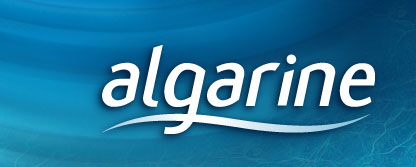Frequently asked questions
1. What is the difference between algarine and
the conventional way of treating pool water?
2. Can algarine also help me obtain higher water
quality in my Jacuzzi or Spa?
3. What is the position of organizations such as Health
Canada with regard to copper-based pool products?
4. Can I begin using algarine mid-season?
5. Is algarine compatible with different types
of chlorine, bromine, peroxide and lithium?
6. What are the different types of chlorine that exist?
7. Should I overchlorinate my pool water?
8. When should I overchlorinate my pool water?
9. Can algarine be used in problem water?
10. Do I need to use products other than algarine?
11. Is algarine compatible with water heaters?
12. Is algarine safe to use?
13. algarine does not contain disinfectant
like other "multifunction" products, WHY ?
1. What is the difference between algarine and the conventional
way of treating pool water?
algarine is a tested and approved product that was introduced
on the market to fill a gap which currently available products have
not been able to fill. In fact, interviews with thousands of pool owners
have allowed us to determine that a number of problems occur during
heat waves, among them:
• Algae formation
• Instability in pH levels
• And questionable water clarity
algarine works to fight off these problems by:
• Controlling algae
• Stabilizing pH levels
• Clarifying water
• Decreasing the amount of chlorine required
All of the ingredients that make up this tested and proven solution
have been stabilized, calibrated and chosen specifically to:
• Reduce the amount of chlorine required.
• Eliminate or diminish the need for any other unnecessary chemical
product when treating pool water.
|
|
2. Can algarine also help me obtain higher water quality in my
Jacuzzi or Spa?
Yes. It is completely safe to use algarine in your Jacuzzi
or Spa.
|
|
3. What is the position of organizations such as Health Canada with regard
to copper-based pool products?
The following Health Canada document highlights the many benefits
of copper sulphate algaecides for swimming pool use, specifying that
they:
• Control algae
• Improve water clarity
• Reduce the amount of chlorine- or bromine-based products needed
They do not however:
• Control micro-organisms such as bacteria and viruses
• Eliminate the need for sanitizers such as chlorine- or bromine-based
pool products
algarine contains 1.5% copper. Copper is efficient and safe
when used appropriately. The unique and certified formulation of algarine
ensures both safety and efficiency.
|
|
4. Can I begin using algarine mid-season?
• You can start using algarine at any time during the season.
• algarine can also be used in water where many chemical
products have already been used.
• algarine can also be used in water with high concentrations
of disinfectants.
Please refer to the “Use” section
for more details.
|
|
5. Is algarine compatible with different types of chlorine, bromine,
lithium and peroxide?
algarine is compatible will all types of chlorine, as well
as bromine, lithium and peroxide (active oxygen).
|
|
6. What are the different types of chlorine available on the market?
algarine is compatible will all types of chlorine.
On the market, you will find the following types of chlorine:
1. Granular chlorine
calcium hypochlorite (HTH)
2. Liquid chlorine
sodium hypochlorite
3. Stabilized chlorine (puck)
trichloro-s-triazinetrione (trichloro-isocyanuric acid)
4. Stabilized chlorine in granular powder
sodium dichloro-s-triazinetrione (sodium dichloro- isocyanurate)
1. Granular chlorine
calcium hypochlorite (HTH)
Developed by OLIN in 1928, this manufacturing process has provided
for producing concentrated chlorine. This process was called “High
Test Hypochlorite.” Nowadays, it is better known as its abbreviation,
HTH. Calcium hypochlorite is often called “granular chlorine”.
It is the form of chlorine most used by pool owners.
• Usual active concentration: 65%
• Available chlorine content: 65%
• pH: 11
Strengths:
• Easily handled
• No significant storage degradation
Weaknesses:
• Raises pH
• Chlorine residual in pool dissipates rapidly in sunlight
2. Liquid chlorine sodium hypochlorite
First produced in 1785 by hypochlorite was produced in a chemical
plant in Javel, France. Sodium hypochlorite is only stable as a solution.
Pool chlorine bleach is usually double the strength of laundry bleach.
• Usual active concentration: 10.8% (12% commercial)
• Available chlorine content: 10.3%
• pH: 13
Strengths:
• Completely miscible in water
• As bulk liquid, it is the most economical source of chlorine
sanitizer
Weaknesses:
• Bulky and heavy to handle
• Bleaches clothes
• Raises pH
• Significant breakdown during storage
• Residual chlorine concentration in pool dissipates rapidly in
sunlight
3. Stabilized chlorine (puck) trichloro-s-triazinetrione (trichloro-
isocyanuric acid)
Sometimes called “trichlor” for brevity, this white granular
powder is most often sold in tablets. Trichlor is the most active of
pool chlorines. This property should be taken into account both in terms
of handling and storage.
• Usual active concentration: 100%
• Available chlorine content: 90%
• Stabilizer content: 56%
• pH: 2.8
Strengths:
• Easily handled
• Slow-dissolving
• Ideal for chlorinators
• Residual chlorine stabilized
Weaknesses:
• Lowers pH
4. Stabilized chlorine in granular powder sodium dichloro-s-triazinetrione
(sodium dichloro- isocyanurate)
This white granular substance is sometimes called “dichlor”
or “sodium dichlor.” Like trichlor, this other form of stabilized
chlorine is popular with residential pool owners.
• Usual active concentration: 100%
• Available chlorine content: 62%
• Stabilizer content: 57%
• pH: 6.7
Strengths:
• Easily handled
• Fast-dissolving
• Little effect on pH
• Residual chlorine stabilized
Weaknesses:
• Most costly form chlorine sanitizer
|
|
 |
7. Should I overchlorinate my pool water?
All experts and regulatory agencies recommend regular overchlorination
of pool water. To achieve this, a disinfectant suited to the quality
of your water must be used. Such overchlorination will ensure irreproachable
microbiologic water quality. (Ask your pool specialist.)
|
|
8. When should I overchlorinate my pool water?
• Follow disinfectant manufacturer and pool specialist recommendations
while keeping in mind that extreme conditions call for more frequent
overchlorinations.
• Overchlorinating is also crucial after heat waves or after intensive
pool use.
• Overchlorination does not affect the efficiency of algarine
in any way.
|
|
9. Can algarine be used in problem water?
Yes. Following the disinfectant shock treatment, dilute a double dose
of algarine (or triple if water temperature exceeds 26°C)
in a bucket of water (preferably warm) and pour it in front of the return
fittings or distribute it around the basin.
|
|
10. Do I need to use products other than algarine?
Only disinfectant (chlorine, bromine, etc.). Nothing else for the
rest of the season. If water is abnormally hard (e.g., artesian well,
etc.), you may have to re-balance the water. In case of doubt, consult
with your pool specialist.
|
|
11. Is algarine compatible with my water heater?
Yes, algarine is completely compatible with all types of
water heaters.
|
|
12. Is algarine safe to use?
algarine is completely safe for all users when it is used
in compliance with the instructions provided on the product label.
algarine is registered by Health Canada and Office Fédéral
de la Santé Publique (Switzerland). This accreditation confirms
that the product is efficient and safe.
As for all other domestic products, you must keep the product container
closed and keep it away from the reach of children.
Since algarine is a chemical product, it must only be mixed
with water. Any other combination may trigger a chemical reaction that
may release heat or harmful gas emanations.
|
|
13. algarine does not contain disinfectant like other "multifunction"
products, WHY ?
The need for disinfectant varies greatly during the course of a season.
With algarine, at the start and at the end of the season, very
little disinfectant is required because the water is colder and less
bathers use the pool.
However, during mid season, both the higher temperatures and the frequent
use of the pool are very demanding on the disinfectant. In order to
keep the concentration of the disinfectant in the water at a safe level
and to keep the water bacteria free, higher levels should be used.
With algarine, you have the choice to use the proper
product at the right time: not more not less.
|
|




